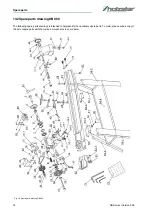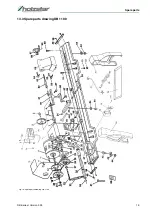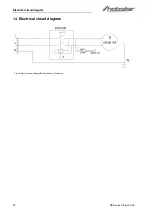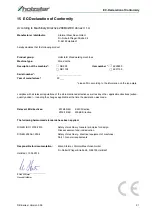
6
DB-Series | Version 3.09
Safety
2.6 Safety instructions
- Before switching on the machine, check that the
workpiece is correctly positioned!
- Never place your hands near rotating parts when
working with the machine!
- Do not remove the sharp-edged chips by hand; use
a hand brush or chip hook!
- Use the guards and secure them securely. Never
work without guards and keep them functional.
Check the functionality before starting work.
- Always keep the machine and its working environ-
ment clean. Ensure adequate lighting.
- Always secure your workpiece when working with
suitable clamping devices. Ensure that there is suffi-
cient contact surface.
- The machine must not be modified in its design and
must not be used for purposes other than those in-
tended by the manufacturer.
- Never work under the influence of concentration-di-
sturbing diseases, overloading, drugs, alcohol or
medication.
- Remove tool keys and other loose parts from the
machine after assembly or repair before switching
on.
- Observe all safety and danger instructions on the
machine and keep it in a perfectly legible condition.
- Keep children and persons unfamiliar with the ma-
chine away from your working environment, ma-
chine and tools.
- The machine may only be used, equipped and main-
tained by persons who are familiar with it and have
been informed of the dangers.
- Do not pull the mains cable around the plug to pull it
out of the socket. Protect the cable from heat, oil and
sharp edges.
- Wear tight-fitting work clothing, safety glasses,
safety shoes and hearing protection. Tie long hair to-
gether. Do not wear watches, bracelets, chains,
rings or gloves (rotating parts!) when working.
- Immediately eliminate any faults that impair safety.
- Never leave the machine unattended in operation
and remain with the machine until the tool has come
to a complete standstill. Then pull out the mains plug
to protect against unintentional switching on.
- Protect the machine from moisture (danger of short
circuits!).
- Never use electric tools and machines in the vicinity
of flammable liquids and gases (danger of explo-
sion!).
- Before each use of the machine, make sure that no
parts are damaged. Damaged parts must be re-
placed immediately to avoid sources of danger!
- Do not overload the machine! You will work better
and safer in the specified power range. Use the cor-
rect tool! Make sure that the tools are not blunt or
damaged.
- Only use original spare parts and accessories to
avoid possible hazards and accident risks.
2.7 Safety instructions for the lathes
- The machine must always be operated by qualified
personnel who are familiar with its operation and
function.
- Always wear eye protection.
- Securely fasten the wood to be processed
- Do not work with cracked or faulty wood
- Use the lowest speed after clamping a new work-
piece.
- Observe the warnings on the machine.
- The clamped material must not be too unbalanced to
prevent ejection.
- Before switching on the motor, turn the clamped
workpiece a few turns by hand to avoid collisions.
- Do not wear work gloves, as they can get caught on
the workpiece.
- Wear a dust mask to protect yourself from wood
dust.
- Prevent the tool from being hooked in during machi-
ning
- Place the tool on the support. Set the cutting edge of
the tool to the center of the workpiece.
- Pay attention to the correct direction of rotation.
- Remove all loose snags before switching on the unit.
- Always ensure that the machine is used and handled
safely.
NOTE!
The instructions for use and maintenance must be
read carefully before starting, using, servicing or
otherwise modifying the machine. Handling and wor-
king with the machine is only permitted to persons
who are thoroughly familiar with the handling and
mode of operation of the machine.
ATTENTION!
Repairs, maintenance and upgrades may only be
carried out by qualified personnel with the machine
switched off (pull the mains plug!)!
ATTENTION!
Make sure that the main switch is in the "OFF" posi-
tion when connecting the machine to the power sup-
ply in order to avoid unintentional switching on.

























